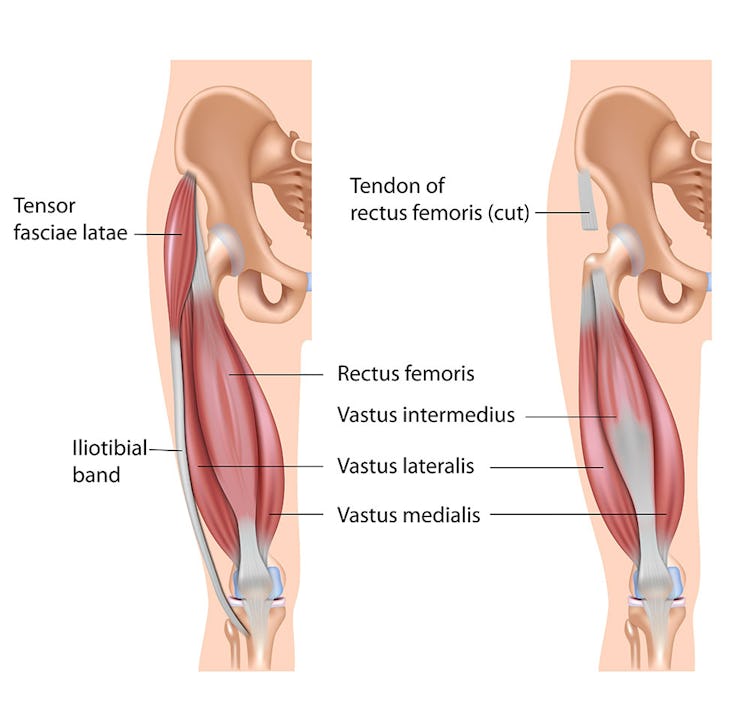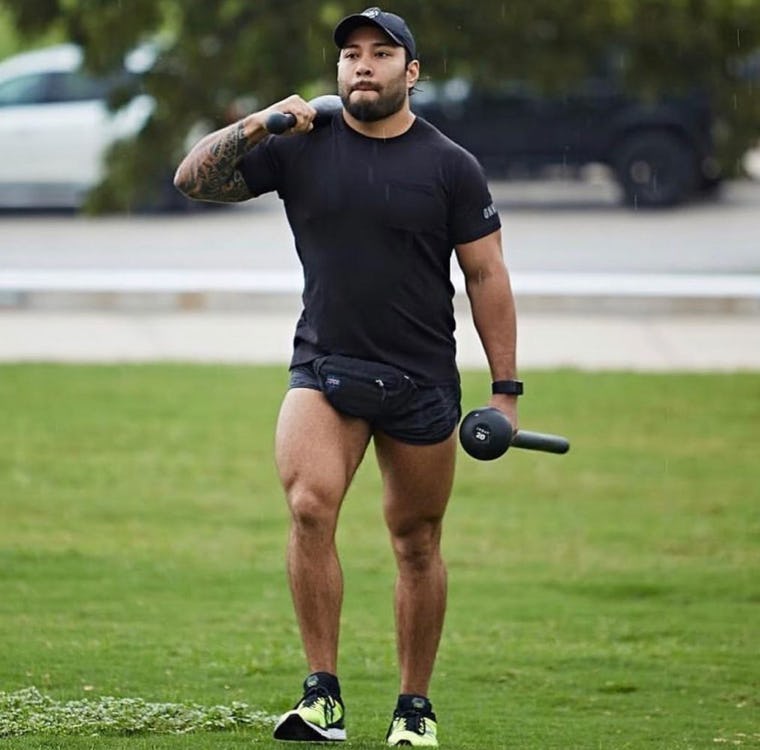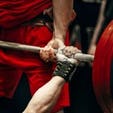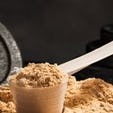Summary
– The quad muscles include the vastus medialis, vastus intermedius, vastus lateralis, and rectus femoris. They extend the knee.
– Injury typically occurs when we take our bodies through ranges of motion and movement patterns that they’re not used to.
– Improving hip and knee mobility can help prevent injury to the joints and quad muscles.
– To prevent knee injury, try to keep your shins vertical during any lower-body training you do.
The Best Quad Stretches & Exercises To Fit Into Your Workout
The quads are some of the biggest muscles in the body, and whether you want to build them up further to avoid hearing taunts like “hey, chicken legs,” or so you can run faster, jump higher, and lift heavier, the quad muscles need to be prepared for anything. We rounded up some mobility drills you’ve probably never tried to help you improve performance and reduce your risk of injury.
What Muscles Make Up Your Quads?

The quadriceps femoris (the quads’ formal name) consists of four different muscles—hence the “quad” name. These are the vastus medialis, vastus intermedius, vastus lateralis, and rectus femoris. The three vastus muscles originate on the femur (thigh) bone, while the rectus femoris originates at the pelvis. All four muscles come together at the kneecap and attach to the shinbone. The quadriceps muscles work to extend the knee.
The vastus medialis is located on the innermost side of the thigh. Bodybuilders call it the “teardrop” muscle when it’s well developed, as the shape it makes going into the knee looks like a droplet of water. The vastus intermedius isn’t visible from the outside, as it lies beneath the rectus femoris muscle, which runs down the center of the thigh. The vastus lateralis extends down the outer side of the thigh.
Why Should You Stretch Your Quadriceps Before Exercising?
The quads connect at the hip and the knee, and while that makes them crucial for producing lower-body strength and explosiveness, it also opens them up to injury at both junctions. “We tend to hurt ourselves in positions or movement patterns that we don’t train or use very often,” says Cristian Plascencia, a mobility coach in Austin, TX (@cristian_thedurableathlete on Instagram). “So you want to get used to exposing your body to end ranges and planes of motion that it’s not used to.” If you never stretch your quads, but one day decide to run some sprints—or you play softball and you find yourself running for home plate—your quad muscles won’t be prepared for the sudden pulling that occurs when fast running creates extreme hip extension. That puts you at greater risk of straining or tearing a muscle.
Plascencia recommends drills that stretch your quads in the end ranges of hip extension and knee flexion before you do any running, jumping, or lower-body strength training. Not only will they help train your quads to move more safely during athletic activities, but they’ll double as a warmup that gets your body ready to move heavy weight on hard exercises like the squat, deadlift, or lunge, and all their variations.
The drills that follow are examples of dynamic stretches—exercises that take muscles through their range of motion actively, as opposed to statically. Static stretching, on the other hand, is when you put a muscle into a stretched position and hold it for time (toe touches, for example). Both types of stretching have their place, but dynamic stretches have been shown to be more effective when done before activity. They don’t inhibit muscle strength, and may even improve your nervous system’s ability to recruit your muscles. A study in the Journal of Strength and Conditioning Research examined the effect of different stretching protocols on quad muscle power. While none of the stretching reduced power, dynamic stretches led to the greatest increases in power during subsequent testing.
Another study found that dynamic stretching before training improved power significantly over not stretching at all.
Quad Stretches to Fit Into Your Workout
Plascencia offers the following dynamic stretches to add to your warmup.
Half-Kneeling Pelvic Tuck
Step 1. Kneel on one knee, resting it on a pad or towel. The knee should be directly under your hip; press your toes firmly into the floor. Tuck your pelvis so that it’s parallel to the floor, and straighten your torso. Draw your shoulders back and down (think: “proud chest”).
Step 2. Bend your hips back while keeping a long spine from your head to your pelvis. Hold for 5 seconds.
Step 3. Drive your knee into the pad as you tuck your pelvis again, and extend your hips to bring your torso back upright. Squeeze your glutes as you extend the hips.
That’s one rep. Perform 3 sets of 5 reps on each side.
Half-Kneeling King Dancer
Step 1. Begin the movement as you did for the half-kneeling pelvic tuck above. Rest on one knee, bend your hips back, and squeeze your glutes as you extend the hips again.
Step 2. Turn your torso toward the back knee and bend your hips as you curl your back leg up. Grasp the top of your foot with your hand.
Step 3. Tuck the pelvis as you extend your hips again while holding onto the back foot. You should feel a strong stretch in the front of the thigh and hip.
That’s one rep. Perform 3 sets of 5 reps on each side.
Shinbox Tripod Extension
Step 1. Sit on the floor with your feet in front of you and knees bent 90 degrees. Rotate your hips and knees to the right until your knees are flat on the floor, your left knee beneath your right foot.
Step 2. Pull your left foot close to your butt so the top of the foot is on the floor. Press your right hand into the floor and pull your ribs down, bracing your core.
Step 3. Extend your hips, pressing your knees into the ground while you squeeze your glutes. Extend your left arm overhead as you come up. Hold the top for one second. Be sure to keep your core tight so that your lower back doesn’t hyperextend.
That’s one rep. Perform 3 sets of 5 reps on each side.
How To Stretch A Quad With A Bad Knee
Plascencia says most people are good at moving forward and backward, but injury often occurs when rotational forces are put on the knee—turning, cutting, or when your knee travels laterally or medially during an exercise. “We don’t think of the knee joint as being able to rotate internally and externally,” says Plascencia, “but it does have degrees of rotation. Moving it through those ranges prepares it to take on load when it’s forced into rotation during activity.”
You can use the egg beater drill (see below) if you’re currently nursing a knee injury. It doesn’t require your knee to support any weight, and it will train the hip and knee joints to rotate internally and externally. The mountain climber with hip twist can be used later to prevent further knee problems, as it targets the leg’s lateral line of fascia—the webbing of connective tissue that links the muscles together. “If you can get greater mobility in that lateral line,” says Plascencia, “you can distribute force more equally down the leg and through the knee. It’s telling your IT band, obliques, and all the other tissues that cross the lower leg and hips that you can use this new range when you’re running, landing, or squatting, and that will take pressure off the quad tendon.”
Egg Beater
Step 1. Hold one end of a foam roller or other sturdy object for support. Stand on one leg (the same side as the roller) and raise your opposite leg off the floor, bringing your knee up to hip level.
Step 2. Keeping your thigh level with the floor, extend your knee, kicking the leg straight out.
Step 3. Bend the knee again as you rotate your lower leg away from the midline of your body, moving it purely from the hip.
Step 4. Rotate your leg toward midline, and then extend your knee again. The entire movement should look like you’re beating an egg and your leg is the whisk. That’s one rep.
Perform 3 sets of 5 reps in each direction on each side.
Mountain Climber Hip Twist
Step 1. Get on all fours on the floor with your hands under your shoulders and knees beneath your hips. Extend your knees so that you come up into the top of a pushup—your body should form a straight line from your head to your heels.
Step 2. Drive your left leg forward until your foot is outside your left hand. From there, slide your left foot back and twist your body slowly so that your right hip bends toward the floor. Drive your right leg into the floor to lengthen the leg and stretch the hip as you bring it to the floor.
Step 3. Pivot onto your left toes as you raise your hips up and back to the pushup position. Bring your left foot up to your hand again, and then switch sides.
That’s one rep. Perform 3 sets of 5 reps on each side.
Tips When Working Your Quads
“You can’t train muscles that act on the knee [like the quads] without paying attention to the ones that act on the hip and ankle,” says Plascencia. Improving your mobility in these areas, even if it’s just with some basic hip flexor stretches and ankle openers, will help your legs move more efficiently, again taking the pressure off the quads and knees.
Furthermore, avoid knee valgus when you train. That is, don’t let your knees cave in or bow out on any movement. Whether you’re jumping, squatting, or lunging, good technique means having your shins perpendicular to the floor so you avoid putting excess strain on the knee joints.
Lastly, Plascencia advises doing more exercises that use different planes of motion—moving laterally or with rotation, as opposed to just forward and back. Not only will this help to improve your movement skills to avoid injury, it will change the way your muscles are recruited, bringing up weak areas and boosting your muscle gains. “Instead of doing standard lunges and squats all the time,” says Plascencia, “do a curtsy or stepover lunge,” [see below for the stepover lunge] or try a squat holding one kettlebell in front of your chest so you have to fight to keep your balance. “If you do four or five leg exercises in a training week, have at least one or two work different planes of motion.”
Stepover Lunge
Step 1. Hold a kettlebell or dumbbell in each hand and step forward with one leg, turning your hips so that your knee points about 90 degrees from your body. You will land with your lead foot perpendicular to your rear one.
Step 2. Lower your body as far as you can—ideally to where your rear knee is just above the floor—while keeping your torso upright. Step back to the starting position and repeat on the opposite leg.

)





